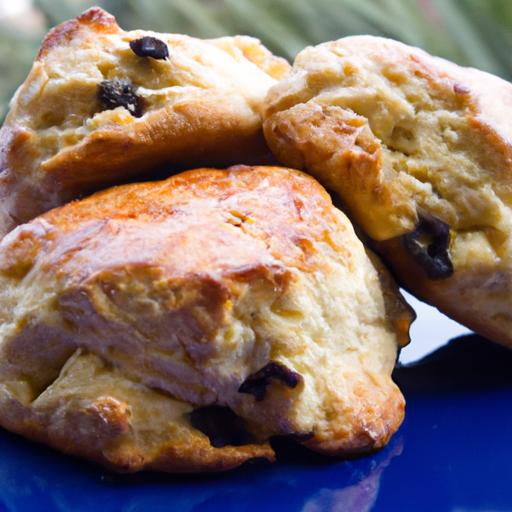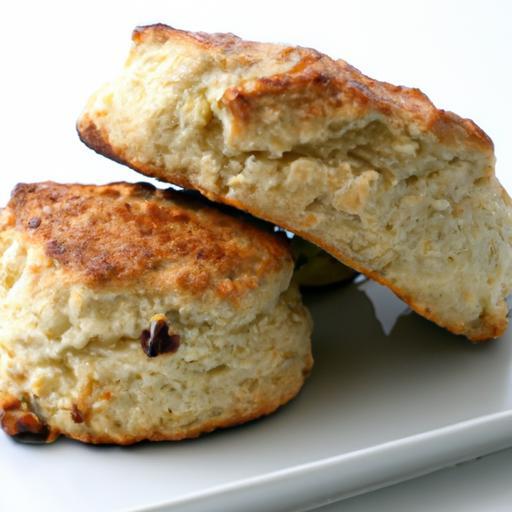There’s nothing quite like the warm, buttery comfort of a freshly baked scone-unless, of course, it turns out dry and crumbly, leaving you with a crumb trail instead of a tender bite. If you’ve ever wondered why your scones lack that irresistible moistness and melt-in-your-mouth texture, you’re not alone. Baking the perfect scone is part art, part science, and knowing where things commonly go wrong can transform your baking game. In this article, we’ll unravel the mysteries behind dry, crumbly scones and share practical, easy-to-apply tips to bring your scones back to their soft, flaky glory. Ready to rescue your next batch? Let’s dive in!
Understanding the Science Behind Dry and Crumbly Scones
Why are my scones dry and crumbly? Fixing common fixes begins with a grasp of the delicate science behind scones. These charming British teatime staples rely on a precise balance of ingredients and gentle handling to achieve their signature tender crumb. Over-mixing or using the wrong flour can lead to tough, dry scones, while too little fat or liquid results in crumbly textures. The magic happens when butter, flour, and liquid marry just right-creating pockets of flakiness without sacrificing moisture. It’s a transformation born from gluten development, cold fats, and a touch of chemistry that every home baker can master with a little know-how.
Choosing the Right Ingredients for Moist and Tender Scones
Start with high-quality all-purpose flour to strike the perfect balance of structure and tenderness. Avoid bread flour as its high protein encourages gluten, making scones tough. Always sift your flour to add air and ensure even mixing. Use cold, unsalted butter, cut into small cubes; this creates steam pockets while baking, resulting in a flaky texture. For moisture, opt for full-fat cream or buttermilk-both add richness and tenderize glutinous proteins. Sugar isn’t just for sweetness; it contributes to a soft crumb and beautiful browning. A pinch of baking powder guarantees lift, while a little salt enhances depth.
Mastering Mixing Techniques to Preserve Flakiness
The key to tender, flaky scones is gentle, minimal mixing. Combine dry ingredients first, then quickly rub in butter with your fingertips until the mixture resembles coarse crumbs. Cold butter is crucial here-it shouldn’t melt into the flour. When adding liquid, stir just until the dough holds together; overworking activates gluten, resulting in dryness and crumbliness. After shaping, handle the dough sparingly to maintain those precious pockets of butter. Remember, cold tools and hands help keep fat solid, enhancing your flaky layers.
Baking Tips to Achieve Perfectly Soft and Buttery Scones
Preheat your oven thoroughly to get an initial burst of heat, essential for rise and light texture. Bake scones on a lined baking sheet to promote even heat distribution. Brush tops with cream or milk mixed with a touch of sugar for a golden, glossy finish. Bake until edges turn lightly golden-overbaking dries them out. Remove from the oven and let cool slightly on a wire rack; resting allows steam to redistribute moisture, keeping scones soft. Transform your baking routine by mastering these subtle adjustments for irresistibly soft, buttery scones every time.
Prep and Cook Time
- Preparation: 15 minutes
- Resting (optional): 10 minutes
- Baking: 15-20 minutes
- Total Time: 30-35 minutes
Yield
Yields 8 medium-sized scones
Difficulty Level
Easy to Medium
Ingredients
- 2 cups all-purpose flour, sifted
- 1/4 cup granulated sugar
- 1 tablespoon baking powder
- 1/2 teaspoon fine sea salt
- 6 tablespoons cold unsalted butter, cubed
- 3/4 cup full-fat buttermilk or heavy cream
- 1 large egg (optional, for brushing)
Instructions
- Preheat your oven to 425°F (220°C) and line a baking sheet with parchment paper.
- In a large mixing bowl, whisk together flour, sugar, baking powder, and salt until combined evenly.
- Using your fingertips or a pastry cutter, cut cold butter into the dry ingredients until the mixture resembles coarse crumbs with pea-sized pieces of butter visible.
- Pour in buttermilk or cream slowly, stirring gently with a fork just until the dough begins to come together. Avoid overmixing to prevent toughness.
- Turn the dough onto a floured surface and pat gently into a 1-inch thick round. Fold the dough over onto itself 2-3 times for layers, then reshape into a circle.
- Using a sharp knife or a bench scraper, cut into 8 wedges. Transfer carefully to the baking sheet, spacing evenly.
- For a glossy golden crust, lightly brush tops with beaten egg or cream mixed with a pinch of sugar.
- Bake for 15-20 minutes or until puffed and golden brown along the edges. Avoid opening the oven door during baking to maintain heat stability.
- Remove from oven and let cool for 5 minutes on the tray, then transfer to a wire rack to prevent sogginess.
Chef’s Notes & Tips for Success
- For extra flavor, fold in fresh berries, lemon zest, or shredded cheese into the dough before shaping.
- Keep all ingredients cold; chill your mixing bowl and pastry cutter to slow butter melting.
- If using frozen fruit, toss in a tablespoon of flour to reduce sogginess.
- Make-ahead tip: Prepare dough, shape, and freeze unbaked scones on a tray. Transfer to a freezer bag. Bake directly from frozen, adding a few extra minutes.
- Refer to our guide on butter types for insights on how butter quality impacts results.
Serving Suggestions
Serve your scones warm, topped with a dollop of clotted cream and your favorite jam, such as tangy raspberry or sweet strawberry. Pair with a steaming pot of English breakfast tea or freshly brewed coffee for a classic teatime experience. For an indulgent twist, add a drizzle of honey or a sprinkle of cinnamon sugar before baking. Garnish with fresh mint leaves or edible flowers for a visually stunning plate that invites smiles around the table.
| Nutrient | Per Scone |
|---|---|
| Calories | 210 kcal |
| Protein | 4 g |
| Carbohydrates | 30 g |
| Fat | 8 g |

For scientifically detailed baking methods and tips on gluten formation, consult King Arthur Baking’s Scone Guide.
Q&A
Q&A: Why Are My Scones Dry and Crumbly? Fixing Common Fixes
Q1: Why do my scones turn out dry and crumbly instead of soft and tender?
A1: Dry, crumbly scones usually mean there’s an imbalance in moisture or fat content. Overmixing the dough or baking too long can also rob your scones of their tender crumb. Think of scones as a delicate dance of ingredients – too dry, too much flour, or too much heat, and you’ll miss the perfect softness.
Q2: Can using the wrong flour make my scones dry?
A2: Absolutely. Using a high-protein flour like bread flour can develop too much gluten, leading to tough, crumbly scones. Opt for all-purpose or a low-protein pastry flour for that soft, melt-in-your-mouth texture.
Q3: How important is the fat in making moist scones?
A3: Fat is the secret handshake of scone-making. Butter or cream coats flour proteins, keeping gluten formation low and moisture locked in. Skimping on fat or swapping butter for a less flavorful fat can leave your scones dry and uninspired.
Q4: What role does liquid play in scone texture?
A4: Liquid hydrates the flour, allowing gluten strands to develop just enough to hold the scone together. Too little, and the dough won’t come together – too much, and you risk sogginess or dense scones. But the right amount keeps them tender and moist.
Q5: Can overmixing really ruin my scones?
A5: Yes, it’s a classic pitfall. Overmixing wakes up gluten too much, resulting in tough, crumbly scones. Mix just until ingredients come together – a few lumps are okay! That light touch is what keeps them fluffy.
Q6: Does baking time affect dryness?
A6: Definitely. Overbaking scones is like leaving a cake in the oven too long – every second past perfection drains moisture. Bake just until golden and a toothpick comes out clean, then pull them out and let residual heat do the rest.
Q7: Any tips to fix dry scones after baking?
A7: A gentle slice and a brush of melted butter or cream while warm can coax moisture back in. Serve with jam or clotted cream to add richness and counter dryness. But for future batches, adjusting ingredients and technique is key.
Q8: How can I experiment to get my perfect scone every time?
A8: Start by measuring carefully and don’t rush the mixing. Try using buttermilk or yogurt for extra moisture and tang. Swap part of the flour for oat flour or almond meal for tenderness. And keep a baking journal – note changes and results, turning every “crumbly” batch into sweet success.
In Retrospect
In the delicate dance of scone-making, a dry and crumbly result can be discouraging, but it’s far from a dead end. Armed with a deeper understanding of your ingredients and techniques-from measuring flour with care to embracing the gentleness of mixing-you’re equipped to turn those stubborn scones into tender, buttery delights. Remember, every batch is a lesson baked in, a chance to perfect the art of crumb and moisture. So next time you face that dry dilemma, think of it as an invitation to experiment, adjust, and ultimately savor the sweet success of scones done right. Happy baking!








